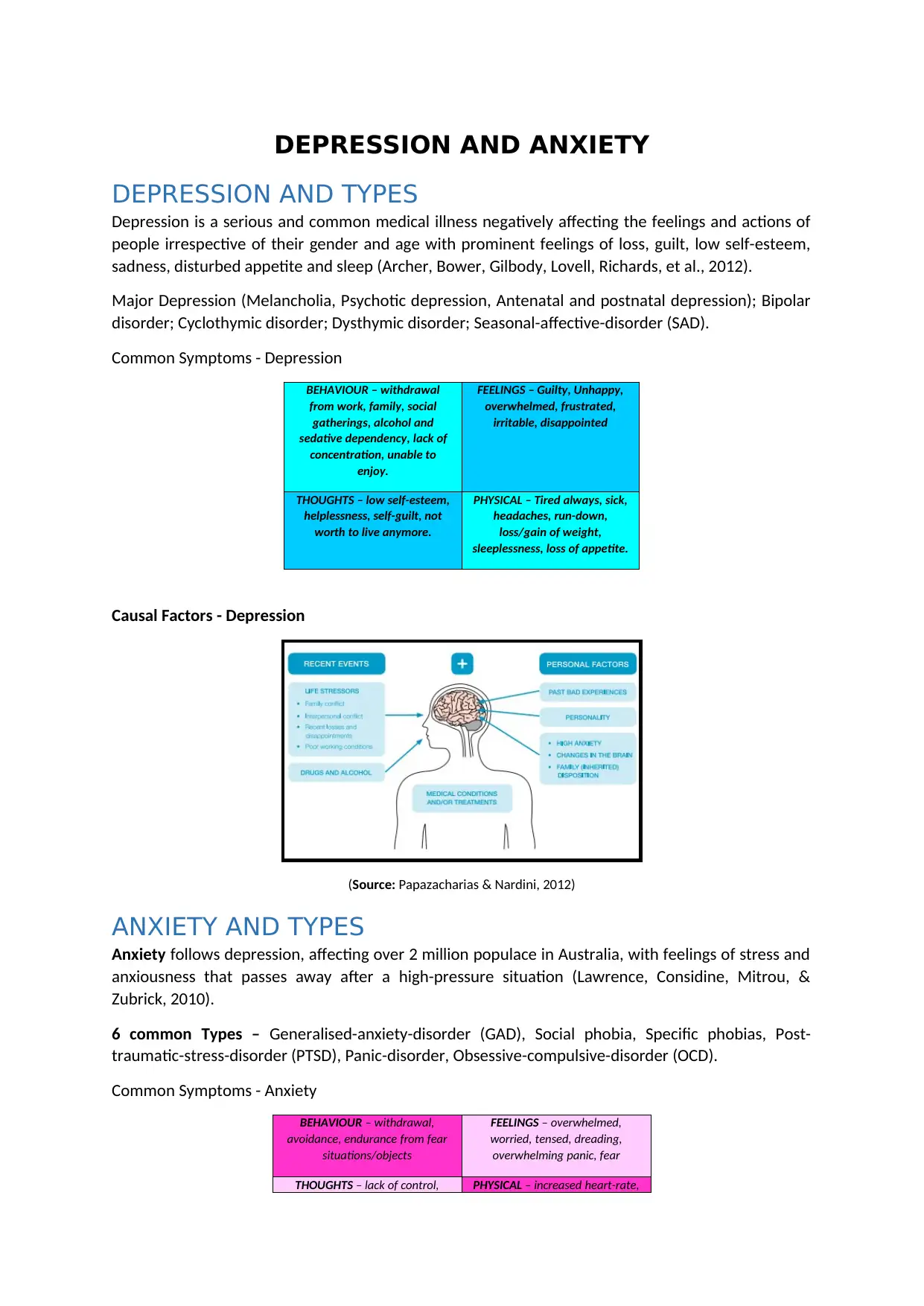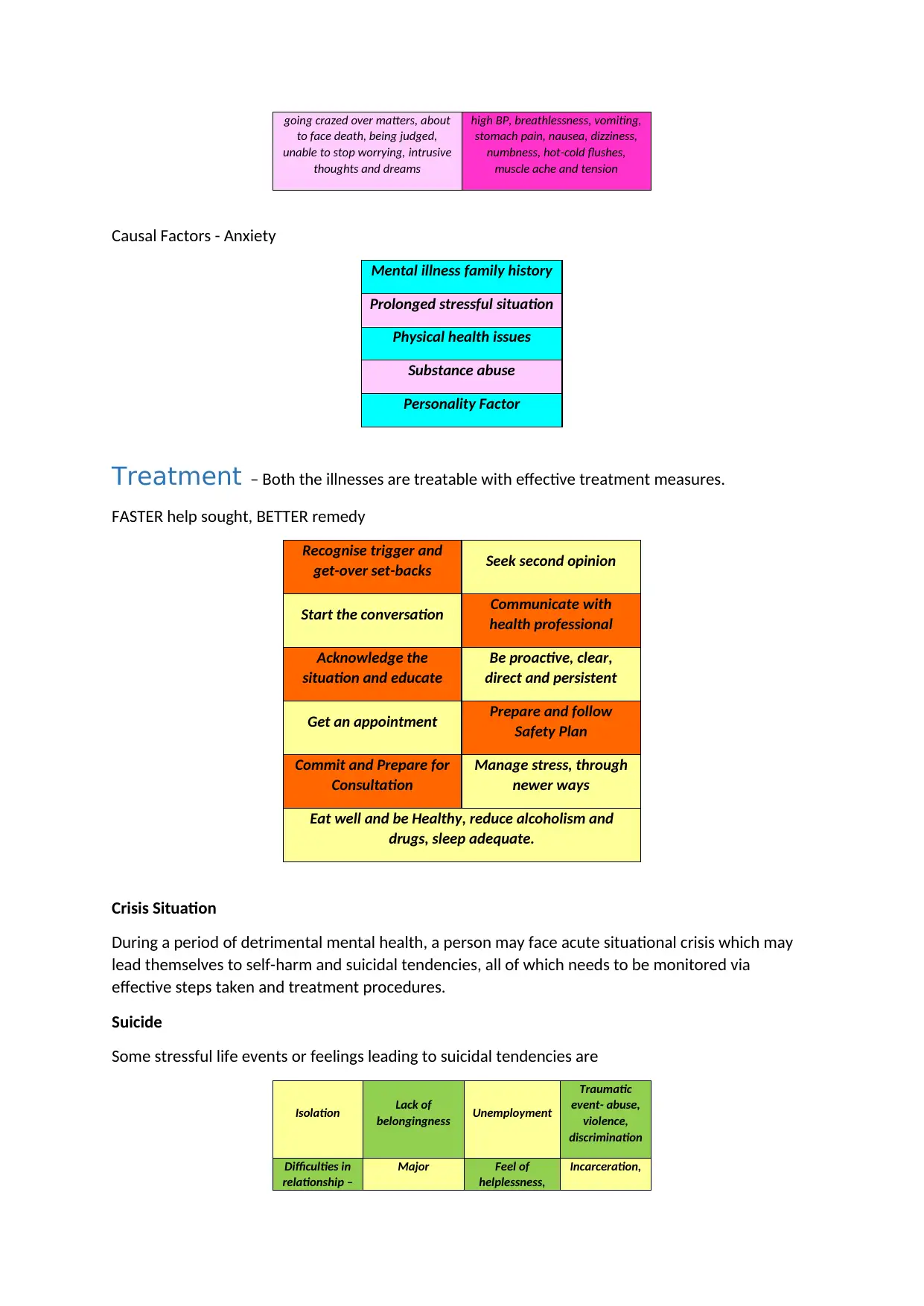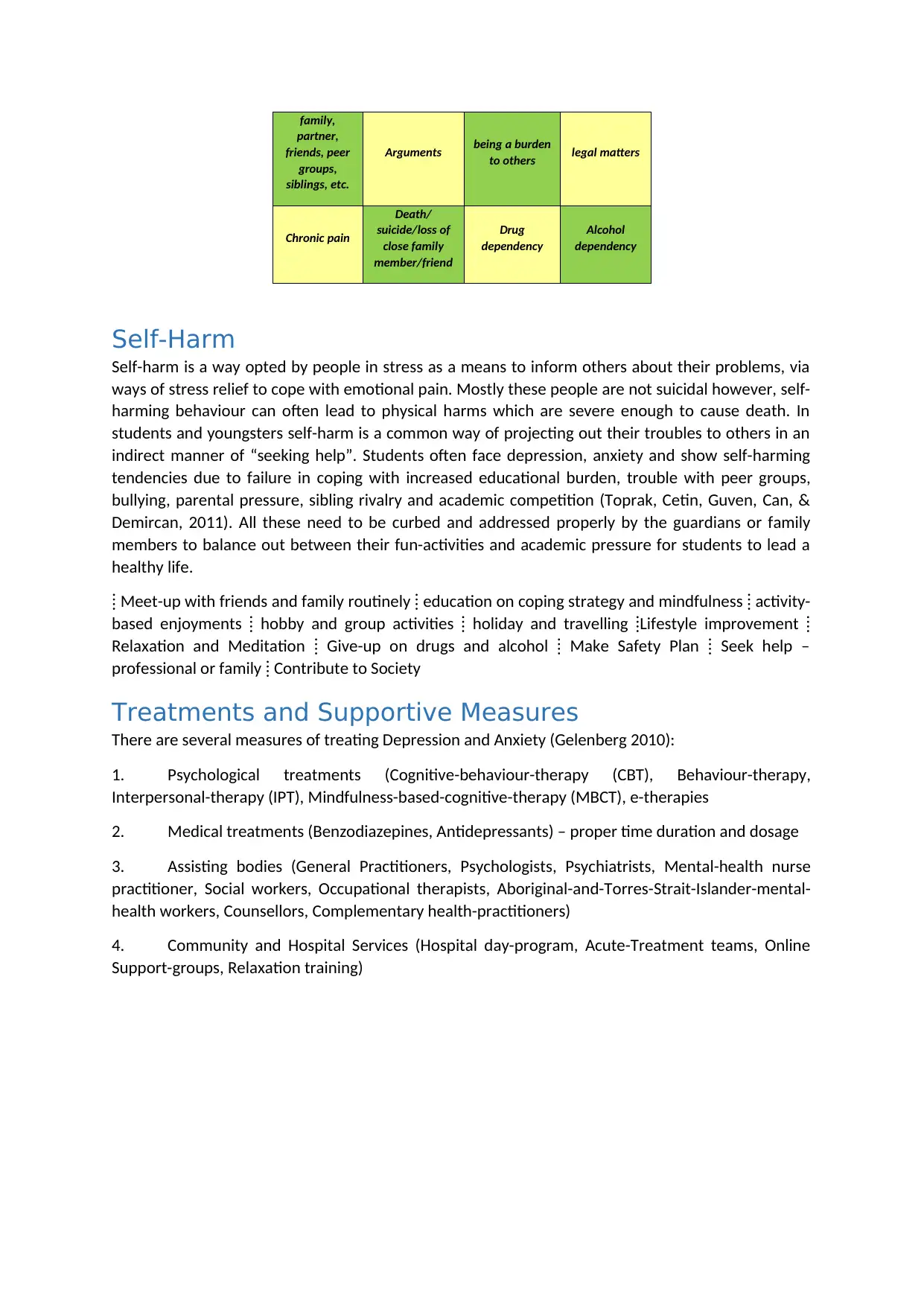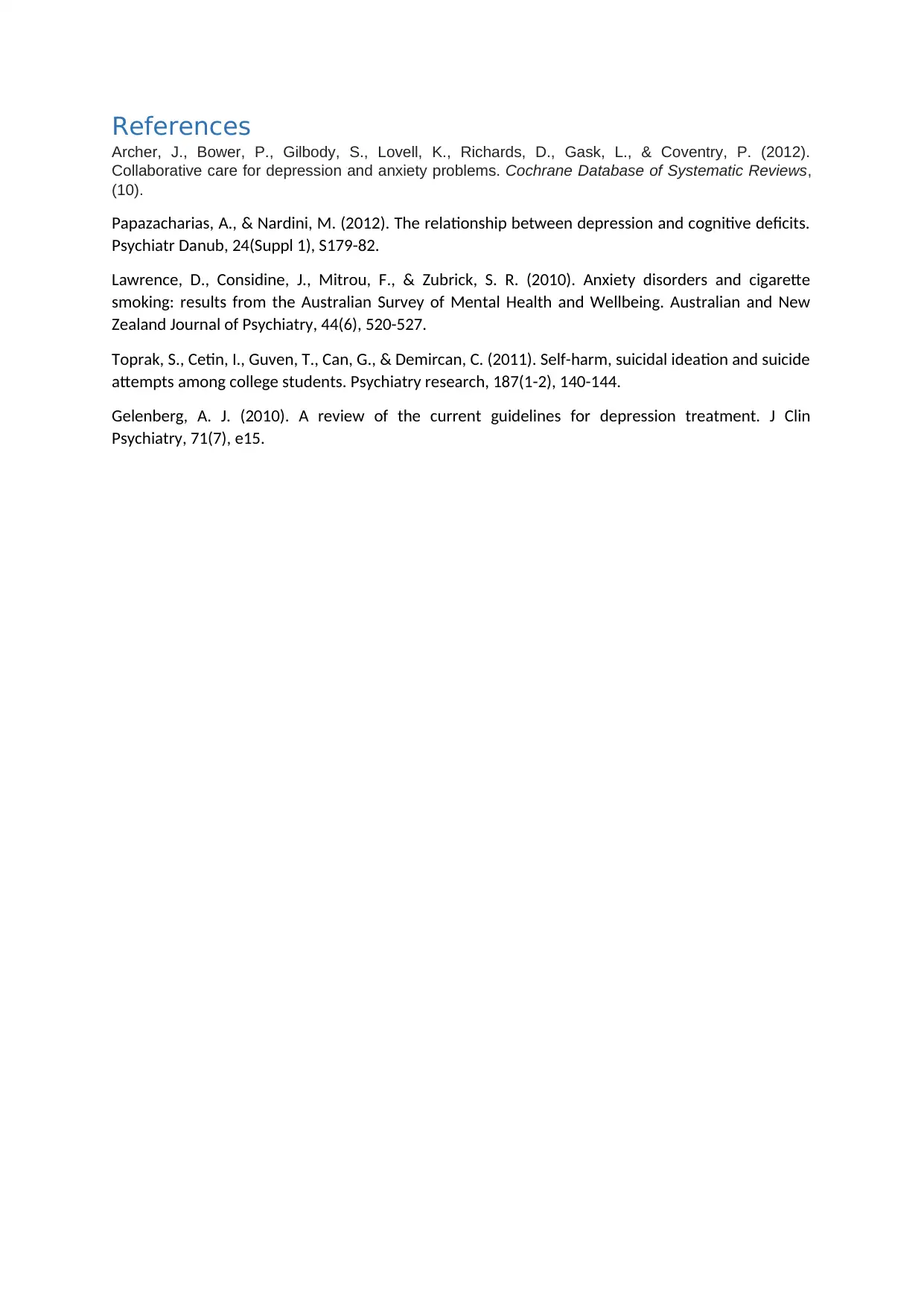Depression and Anxiety Issue 2022
VerifiedAdded on 2022/10/15
|4
|1212
|17
AI Summary
Contribute Materials
Your contribution can guide someone’s learning journey. Share your
documents today.

DEPRESSION AND ANXIETY
DEPRESSION AND TYPES
Depression is a serious and common medical illness negatively affecting the feelings and actions of
people irrespective of their gender and age with prominent feelings of loss, guilt, low self-esteem,
sadness, disturbed appetite and sleep (Archer, Bower, Gilbody, Lovell, Richards, et al., 2012).
Major Depression (Melancholia, Psychotic depression, Antenatal and postnatal depression); Bipolar
disorder; Cyclothymic disorder; Dysthymic disorder; Seasonal-affective-disorder (SAD).
Common Symptoms - Depression
BEHAVIOUR – withdrawal
from work, family, social
gatherings, alcohol and
sedative dependency, lack of
concentration, unable to
enjoy.
FEELINGS – Guilty, Unhappy,
overwhelmed, frustrated,
irritable, disappointed
THOUGHTS – low self-esteem,
helplessness, self-guilt, not
worth to live anymore.
PHYSICAL – Tired always, sick,
headaches, run-down,
loss/gain of weight,
sleeplessness, loss of appetite.
Causal Factors - Depression
(Source: Papazacharias & Nardini, 2012)
ANXIETY AND TYPES
Anxiety follows depression, affecting over 2 million populace in Australia, with feelings of stress and
anxiousness that passes away after a high-pressure situation (Lawrence, Considine, Mitrou, &
Zubrick, 2010).
6 common Types – Generalised-anxiety-disorder (GAD), Social phobia, Specific phobias, Post-
traumatic-stress-disorder (PTSD), Panic-disorder, Obsessive-compulsive-disorder (OCD).
Common Symptoms - Anxiety
BEHAVIOUR – withdrawal,
avoidance, endurance from fear
situations/objects
FEELINGS – overwhelmed,
worried, tensed, dreading,
overwhelming panic, fear
THOUGHTS – lack of control, PHYSICAL – increased heart-rate,
DEPRESSION AND TYPES
Depression is a serious and common medical illness negatively affecting the feelings and actions of
people irrespective of their gender and age with prominent feelings of loss, guilt, low self-esteem,
sadness, disturbed appetite and sleep (Archer, Bower, Gilbody, Lovell, Richards, et al., 2012).
Major Depression (Melancholia, Psychotic depression, Antenatal and postnatal depression); Bipolar
disorder; Cyclothymic disorder; Dysthymic disorder; Seasonal-affective-disorder (SAD).
Common Symptoms - Depression
BEHAVIOUR – withdrawal
from work, family, social
gatherings, alcohol and
sedative dependency, lack of
concentration, unable to
enjoy.
FEELINGS – Guilty, Unhappy,
overwhelmed, frustrated,
irritable, disappointed
THOUGHTS – low self-esteem,
helplessness, self-guilt, not
worth to live anymore.
PHYSICAL – Tired always, sick,
headaches, run-down,
loss/gain of weight,
sleeplessness, loss of appetite.
Causal Factors - Depression
(Source: Papazacharias & Nardini, 2012)
ANXIETY AND TYPES
Anxiety follows depression, affecting over 2 million populace in Australia, with feelings of stress and
anxiousness that passes away after a high-pressure situation (Lawrence, Considine, Mitrou, &
Zubrick, 2010).
6 common Types – Generalised-anxiety-disorder (GAD), Social phobia, Specific phobias, Post-
traumatic-stress-disorder (PTSD), Panic-disorder, Obsessive-compulsive-disorder (OCD).
Common Symptoms - Anxiety
BEHAVIOUR – withdrawal,
avoidance, endurance from fear
situations/objects
FEELINGS – overwhelmed,
worried, tensed, dreading,
overwhelming panic, fear
THOUGHTS – lack of control, PHYSICAL – increased heart-rate,
Secure Best Marks with AI Grader
Need help grading? Try our AI Grader for instant feedback on your assignments.

going crazed over matters, about
to face death, being judged,
unable to stop worrying, intrusive
thoughts and dreams
high BP, breathlessness, vomiting,
stomach pain, nausea, dizziness,
numbness, hot-cold flushes,
muscle ache and tension
Causal Factors - Anxiety
Mental illness family history
Prolonged stressful situation
Physical health issues
Substance abuse
Personality Factor
Treatment – Both the illnesses are treatable with effective treatment measures.
FASTER help sought, BETTER remedy
Recognise trigger and
get-over set-backs Seek second opinion
Start the conversation Communicate with
health professional
Acknowledge the
situation and educate
Be proactive, clear,
direct and persistent
Get an appointment Prepare and follow
Safety Plan
Commit and Prepare for
Consultation
Manage stress, through
newer ways
Eat well and be Healthy, reduce alcoholism and
drugs, sleep adequate.
Crisis Situation
During a period of detrimental mental health, a person may face acute situational crisis which may
lead themselves to self-harm and suicidal tendencies, all of which needs to be monitored via
effective steps taken and treatment procedures.
Suicide
Some stressful life events or feelings leading to suicidal tendencies are
Isolation Lack of
belongingness Unemployment
Traumatic
event- abuse,
violence,
discrimination
Difficulties in
relationship –
Major Feel of
helplessness,
Incarceration,
to face death, being judged,
unable to stop worrying, intrusive
thoughts and dreams
high BP, breathlessness, vomiting,
stomach pain, nausea, dizziness,
numbness, hot-cold flushes,
muscle ache and tension
Causal Factors - Anxiety
Mental illness family history
Prolonged stressful situation
Physical health issues
Substance abuse
Personality Factor
Treatment – Both the illnesses are treatable with effective treatment measures.
FASTER help sought, BETTER remedy
Recognise trigger and
get-over set-backs Seek second opinion
Start the conversation Communicate with
health professional
Acknowledge the
situation and educate
Be proactive, clear,
direct and persistent
Get an appointment Prepare and follow
Safety Plan
Commit and Prepare for
Consultation
Manage stress, through
newer ways
Eat well and be Healthy, reduce alcoholism and
drugs, sleep adequate.
Crisis Situation
During a period of detrimental mental health, a person may face acute situational crisis which may
lead themselves to self-harm and suicidal tendencies, all of which needs to be monitored via
effective steps taken and treatment procedures.
Suicide
Some stressful life events or feelings leading to suicidal tendencies are
Isolation Lack of
belongingness Unemployment
Traumatic
event- abuse,
violence,
discrimination
Difficulties in
relationship –
Major Feel of
helplessness,
Incarceration,

family,
partner,
friends, peer
groups,
siblings, etc.
Arguments being a burden
to others legal matters
Chronic pain
Death/
suicide/loss of
close family
member/friend
Drug
dependency
Alcohol
dependency
Self-Harm
Self-harm is a way opted by people in stress as a means to inform others about their problems, via
ways of stress relief to cope with emotional pain. Mostly these people are not suicidal however, self-
harming behaviour can often lead to physical harms which are severe enough to cause death. In
students and youngsters self-harm is a common way of projecting out their troubles to others in an
indirect manner of “seeking help”. Students often face depression, anxiety and show self-harming
tendencies due to failure in coping with increased educational burden, trouble with peer groups,
bullying, parental pressure, sibling rivalry and academic competition (Toprak, Cetin, Guven, Can, &
Demircan, 2011). All these need to be curbed and addressed properly by the guardians or family
members to balance out between their fun-activities and academic pressure for students to lead a
healthy life.
⁞ Meet-up with friends and family routinely ⁞ education on coping strategy and mindfulness ⁞ activity-
based enjoyments ⁞ hobby and group activities ⁞ holiday and travelling ⁞Lifestyle improvement ⁞
Relaxation and Meditation ⁞ Give-up on drugs and alcohol ⁞ Make Safety Plan ⁞ Seek help –
professional or family ⁞ Contribute to Society
Treatments and Supportive Measures
There are several measures of treating Depression and Anxiety (Gelenberg 2010):
1. Psychological treatments (Cognitive-behaviour-therapy (CBT), Behaviour-therapy,
Interpersonal-therapy (IPT), Mindfulness-based-cognitive-therapy (MBCT), e-therapies
2. Medical treatments (Benzodiazepines, Antidepressants) – proper time duration and dosage
3. Assisting bodies (General Practitioners, Psychologists, Psychiatrists, Mental-health nurse
practitioner, Social workers, Occupational therapists, Aboriginal-and-Torres-Strait-Islander-mental-
health workers, Counsellors, Complementary health-practitioners)
4. Community and Hospital Services (Hospital day-program, Acute-Treatment teams, Online
Support-groups, Relaxation training)
partner,
friends, peer
groups,
siblings, etc.
Arguments being a burden
to others legal matters
Chronic pain
Death/
suicide/loss of
close family
member/friend
Drug
dependency
Alcohol
dependency
Self-Harm
Self-harm is a way opted by people in stress as a means to inform others about their problems, via
ways of stress relief to cope with emotional pain. Mostly these people are not suicidal however, self-
harming behaviour can often lead to physical harms which are severe enough to cause death. In
students and youngsters self-harm is a common way of projecting out their troubles to others in an
indirect manner of “seeking help”. Students often face depression, anxiety and show self-harming
tendencies due to failure in coping with increased educational burden, trouble with peer groups,
bullying, parental pressure, sibling rivalry and academic competition (Toprak, Cetin, Guven, Can, &
Demircan, 2011). All these need to be curbed and addressed properly by the guardians or family
members to balance out between their fun-activities and academic pressure for students to lead a
healthy life.
⁞ Meet-up with friends and family routinely ⁞ education on coping strategy and mindfulness ⁞ activity-
based enjoyments ⁞ hobby and group activities ⁞ holiday and travelling ⁞Lifestyle improvement ⁞
Relaxation and Meditation ⁞ Give-up on drugs and alcohol ⁞ Make Safety Plan ⁞ Seek help –
professional or family ⁞ Contribute to Society
Treatments and Supportive Measures
There are several measures of treating Depression and Anxiety (Gelenberg 2010):
1. Psychological treatments (Cognitive-behaviour-therapy (CBT), Behaviour-therapy,
Interpersonal-therapy (IPT), Mindfulness-based-cognitive-therapy (MBCT), e-therapies
2. Medical treatments (Benzodiazepines, Antidepressants) – proper time duration and dosage
3. Assisting bodies (General Practitioners, Psychologists, Psychiatrists, Mental-health nurse
practitioner, Social workers, Occupational therapists, Aboriginal-and-Torres-Strait-Islander-mental-
health workers, Counsellors, Complementary health-practitioners)
4. Community and Hospital Services (Hospital day-program, Acute-Treatment teams, Online
Support-groups, Relaxation training)

References
Archer, J., Bower, P., Gilbody, S., Lovell, K., Richards, D., Gask, L., & Coventry, P. (2012).
Collaborative care for depression and anxiety problems. Cochrane Database of Systematic Reviews,
(10).
Papazacharias, A., & Nardini, M. (2012). The relationship between depression and cognitive deficits.
Psychiatr Danub, 24(Suppl 1), S179-82.
Lawrence, D., Considine, J., Mitrou, F., & Zubrick, S. R. (2010). Anxiety disorders and cigarette
smoking: results from the Australian Survey of Mental Health and Wellbeing. Australian and New
Zealand Journal of Psychiatry, 44(6), 520-527.
Toprak, S., Cetin, I., Guven, T., Can, G., & Demircan, C. (2011). Self-harm, suicidal ideation and suicide
attempts among college students. Psychiatry research, 187(1-2), 140-144.
Gelenberg, A. J. (2010). A review of the current guidelines for depression treatment. J Clin
Psychiatry, 71(7), e15.
Archer, J., Bower, P., Gilbody, S., Lovell, K., Richards, D., Gask, L., & Coventry, P. (2012).
Collaborative care for depression and anxiety problems. Cochrane Database of Systematic Reviews,
(10).
Papazacharias, A., & Nardini, M. (2012). The relationship between depression and cognitive deficits.
Psychiatr Danub, 24(Suppl 1), S179-82.
Lawrence, D., Considine, J., Mitrou, F., & Zubrick, S. R. (2010). Anxiety disorders and cigarette
smoking: results from the Australian Survey of Mental Health and Wellbeing. Australian and New
Zealand Journal of Psychiatry, 44(6), 520-527.
Toprak, S., Cetin, I., Guven, T., Can, G., & Demircan, C. (2011). Self-harm, suicidal ideation and suicide
attempts among college students. Psychiatry research, 187(1-2), 140-144.
Gelenberg, A. J. (2010). A review of the current guidelines for depression treatment. J Clin
Psychiatry, 71(7), e15.
1 out of 4
Related Documents
Your All-in-One AI-Powered Toolkit for Academic Success.
+13062052269
info@desklib.com
Available 24*7 on WhatsApp / Email
![[object Object]](/_next/static/media/star-bottom.7253800d.svg)
Unlock your academic potential
© 2024 | Zucol Services PVT LTD | All rights reserved.





